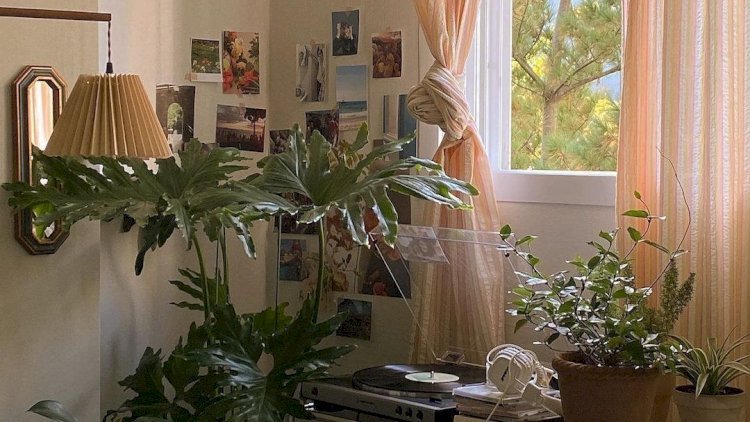13 Cool Plants for Bedroom Décor to Refresh Your Space
Discover the best cool plants for bedroom décor that purify air, reduce stress, and add natural calm to your room. Perfect low-light indoor plants for 2025.

Discover the best cool plants for bedroom décor that improve air quality and create a calm, refreshing space. From low-light favorites like snake plants and ZZ plants to elegant peace lilies, find great bedroom plants that purify the air, reduce stress, and make your room feel naturally peaceful.
Adding plants to your bedroom isn’t just about aesthetics — it’s about creating a calm, restorative environment that supports both physical and mental well-being. Indoor plants improve air quality, lift your mood, reduce stress, and bring a bit of the outdoors inside. In a world filled with screens and artificial light, even a single plant can make your bedroom feel more alive and balanced.
If you’re looking for cool plants for bedroom décor that are easy to maintain, thrive in low light, and naturally purify the air, this guide explores the best bedroom plants to refresh your space — and your mind.
Why Bedroom Plants Are Worth Having

Image source: Pinterest.com
Your bedroom is where you spend a third of your life, and its air quality can directly impact how you sleep and feel each day. Indoor plants contribute to a healthier atmosphere by filtering toxins, increasing oxygen, and regulating humidity.
Research, including NASA’s landmark Clean Air Study, found that certain plants can absorb common household pollutants such as formaldehyde, benzene, and carbon monoxide — chemicals released from items like furniture, flooring, and paint.
In addition to cleaning the air, plants have proven psychological benefits. Studies by the University of Technology Sydney and other institutions show that having plants in the home can lower anxiety, improve focus, and even boost creativity. In short, plants don’t just decorate your space; they nurture your well-being.
The Best Bedroom Plants for Style and Fresh Air
1. Snake Plant (Sansevieria trifasciata)

Image source: Pinterest.com
The snake plant is practically indestructible. Often called “Mother-in-Law’s Tongue,” it has long, sword-like leaves that fit beautifully in modern interiors. It’s one of the few plants that releases oxygen at night, improving air quality while you sleep. Snake plants are also effective at removing formaldehyde and benzene, two of the most common indoor toxins.
They thrive in low light and require minimal watering — once every two to three weeks is often enough. Place one beside your bed or near a sunny window for best results.
2. Spider Plant (Chlorophytum comosum)

Image source: Pinterest.com
The spider plant is a cheerful addition to any room. Its cascading green and white striped leaves add movement and life to shelves or hanging baskets. It’s known for removing carbon monoxide, xylene, and formaldehyde, making it especially useful in stuffy bedrooms.
Spider plants are also pet-safe and easy to propagate — simply snip off one of the baby “spiders” to grow a new plant. They prefer bright, indirect light and light watering once the top of the soil is dry.
3. Peace Lily (Spathiphyllum spp.)

Image source: Pinterest.com
With its deep green leaves and elegant white blooms, the peace lily brings a touch of sophistication to any space. It’s excellent at filtering ammonia, benzene, and formaldehyde, and even helps reduce acetone vapors from cosmetics and cleaning products.
Peace lilies prefer low to medium light and slightly moist soil. They’ll droop slightly when they need water — a built-in reminder for busy plant owners. Because they’re mildly toxic, keep them out of reach of pets and small children.
4. Golden Pothos (Epipremnum aureum)

Image source: Pinterest.com
Known as “Devil’s Ivy” for its resilience, golden pothos is nearly impossible to kill. It thrives in low light, tolerates irregular watering, and purifies the air of formaldehyde, benzene, and carbon monoxide.
Its trailing vines make it perfect for hanging planters or high shelves. The variegated green-and-yellow leaves add a pop of color and freshness to any space. For an extra design touch, train your pothos to climb along a wall or headboard.
5. Boston Fern (Nephrolepis exaltata)

Image source: Pinterest.com
If your bedroom tends to be dry, the Boston fern is an excellent choice. This lush, feathery plant increases humidity while filtering xylene and formaldehyde. It’s also a natural fit for bathrooms due to its love of moisture and indirect light.
Boston ferns require slightly more attention — regular misting and watering are key to keeping their fronds full and green. They add a classic, elegant texture that complements both vintage and modern interiors.
6. Rubber Plant (Ficus elastica)

Image source: Pinterest.com
For a bold statement, few plants match the rubber plant. Its large, glossy leaves make a visual impact while efficiently removing formaldehyde and toluene from the air.
Rubber plants prefer bright, indirect light but can adapt to moderate conditions. Let the soil dry out between waterings to prevent root rot. They’re particularly suited for minimalist bedrooms, where their sculptural form can stand out as a natural centerpiece.
7. Chinese Evergreen (Aglaonema modestum)

Image source: Pinterest.com
The Chinese evergreen is both colorful and forgiving. Its patterned leaves — speckled in silver, green, or red — bring a tropical touch to shaded bedrooms. It’s an effective filter for benzene and formaldehyde, and it’s one of the most adaptable plants for low light environments.
It’s a great option for people who want the benefits of indoor greenery without demanding care routines. Water when the soil feels dry, and it will thrive effortlessly.
8. Philodendron

Image source: Pinterest.com
The heart-leaf philodendron is a timeless favorite for good reason. Its lush, cascading vines are easy to train along shelves or hanging pots, and it excels at absorbing formaldehyde — a chemical released from household materials.
Philodendrons prefer indirect light and moderate watering. Allow the top inch of soil to dry before watering again. For a fuller look, pinch back the growing tips occasionally to encourage new growth.
Read Also: Home Decor Design Interior Ideas to Give Your Home a Luxurious Look
9. ZZ Plant (Zamioculcas zamiifolia)

Image source: Pinterest.com
If you have limited natural light, the ZZ plant is a perfect fit. Its waxy, dark green leaves reflect light beautifully while removing airborne toxins. It’s famous for its ability to survive neglect, needing water only every few weeks.
ZZ plants are ideal for people with busy lifestyles or rooms with minimal sunlight. They’re drought-tolerant, stylish, and among the easiest plants to keep alive year-round.
10. Dracaena

Image source: Pinterest.com
Dracaena varieties, such as the “Corn Plant” or “Janet Craig,” bring height and structure to your bedroom. They help remove benzene, formaldehyde, and trichloroethylene — a chemical found in cleaning products and adhesives.
Dracaenas grow slowly but steadily in low to medium light. Keep the soil slightly moist but never soggy. Their upright form makes them a great natural divider in spacious rooms.
11. Areca Palm (Dypsis lutescens)

Image source: Pinterest.com
If you have a sunny corner, the areca palm adds an instant tropical feel. It’s one of the best plants for increasing indoor humidity and filtering toluene, xylene, and carbon dioxide.
With soft, arching fronds, the areca palm creates movement and warmth. It prefers bright, indirect light and regular watering, making it perfect for bedrooms that get morning sun.
12. English Ivy (Hedera helix)

Image source: Pinterest.com
English ivy’s trailing vines bring a cozy, romantic touch to bedrooms or bathrooms. It’s known for reducing mold spores and absorbing airborne toxins like benzene and formaldehyde.
It does best in moderate light with slightly moist soil. Consider letting it cascade from a hanging planter or windowsill for an elegant, timeless look.
13. Aloe Vera (Aloe barbadensis miller)

Image source: Pinterest.com
Aloe vera is best known for its healing gel, but it’s also an effective air purifier. Like the snake plant, it releases oxygen at night, making it perfect for bedside tables.
Aloe thrives in bright, indirect light and needs very little water. Beyond its air-cleaning ability, you can use its gel for burns or skin care — a practical bonus for any bedroom.
How Plants Improve Indoor Air

Image source: Pinterest.com
Our homes are filled with unseen pollutants released by paint, adhesives, fabrics, and synthetic materials. Plants improve air quality through phytoremediation — a natural process where roots and leaves absorb and break down these compounds.
They also increase humidity by releasing water vapor during transpiration, which can prevent dry throats, colds, and skin irritation. Some plants, such as the areca palm and Boston fern, are especially effective in dry climates.
Another overlooked benefit is their ability to produce negative ions, which bind to dust and allergens, causing them to settle out of the air. This can help allergy sufferers breathe easier and sleep more soundly.
Placement and Care Tips

Image source: Pinterest.com
To maximize their benefits, place plants near a window with filtered light — east-facing windows are ideal. Avoid direct sunlight, which can scorch leaves. Rotate your plants every few weeks to ensure even growth, and wipe their leaves gently with a damp cloth to remove dust and improve photosynthesis.
Grouping plants together can also create a micro-humid environment, helping them (and you) stay hydrated. For smaller bedrooms, opt for vertical planters or hanging baskets to save space.
When it comes to watering, less is more. Overwatering is the most common cause of plant problems. Check the soil first — if the top inch is dry, it’s time to water. Use pots with drainage holes to prevent root rot.
Additional Tricks for Thriving Plants

Image source: Pinterest.com
-
Feed your plants every 4–6 weeks during the growing season (spring and summer) with a mild indoor plant fertilizer.
-
Repot annually to refresh the soil and give roots space to grow.
-
Use filtered or rainwater if your tap water contains high chlorine or fluoride levels.
-
Dust leaves regularly — clean leaves absorb more pollutants and look healthier.
-
Monitor humidity using a small room humidifier during dry months.
-
Trim yellow leaves promptly to encourage new growth and prevent disease.
Common Myths About Bedroom Plants

Image source: Pinterest.com
A common myth is that plants release too much carbon dioxide at night. While it’s true that photosynthesis pauses after dark, the CO₂ they emit is minimal — far less than what humans or pets produce. Plants like the snake plant and aloe vera even release oxygen overnight, improving air freshness.
Another misconception is that plants attract insects. In reality, pests appear mainly when soil remains damp for too long. Proper watering and occasional inspection prevent this issue.
Lastly, many believe indoor plants require bright sunlight. In fact, many species — like the ZZ plant, philodendron, and Chinese evergreen — thrive in low-light bedrooms.
Final Thoughts
Adding plants to your bedroom is one of the simplest ways to improve your quality of life. They purify the air, balance humidity, and create a peaceful atmosphere where you can unwind and recharge.
From the resilient snake plant to the elegant peace lily, every plant on this list offers its own mix of beauty and function. Choose a few that suit your lighting and lifestyle, and you’ll soon notice the difference — not just in your decor, but in how refreshed and relaxed you feel.
Creating a green corner in your bedroom isn’t a trend; it’s an investment in better living. With the right care and a little consistency, your plants will thrive — and so will you.
FAQs About Bedroom Plants
1. What are the best plants to keep in a bedroom?
Snake plant, peace lily, pothos, rubber plant, and aloe vera are great options. They’re easy to maintain and effective at purifying indoor air.
2. Do bedroom plants really clean the air?
Yes. Studies show that plants like spider plants and English ivy absorb harmful toxins, improving overall air quality and reducing pollutants.
3. Which bedroom plants release oxygen at night?
Snake plants and aloe vera are among the few that release oxygen after dark, supporting better sleep quality.
4. Are bedroom plants safe for pets?
Not all. Avoid peace lilies and philodendrons if you have pets. Pet-safe choices include spider plants, areca palms, and Boston ferns.
5. Can plants help with sleep quality?
Indirectly, yes. They reduce stress and purify the air, creating a calming environment that promotes deeper rest.
6. How many plants should I keep in my bedroom?
One to three medium plants are usually enough. Too many can raise humidity levels and crowd your space.
7. What plants are best for low-light bedrooms?
ZZ plants, snake plants, and Chinese evergreens thrive in dim light and require minimal watering.




























